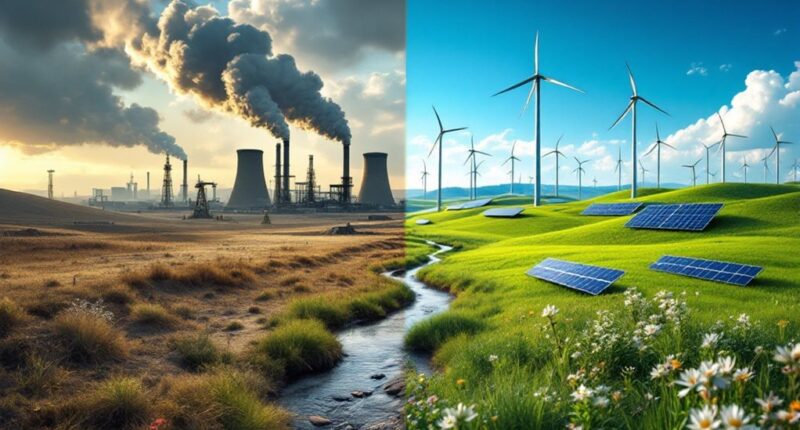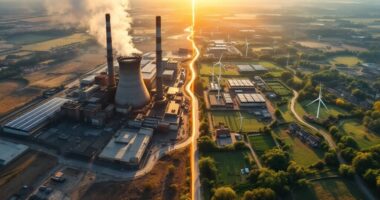The green energy change marks a global shift from fossil fuels to renewables like solar and wind, which now often cost less than traditional energy sources. This transformation requires tripling renewable capacity by 2030—a challenge comparable to climbing Everest. Despite hurdles like intermittent generation and grid upgrades, the benefits include job creation, improved health, and reduced emissions. The $5.7 trillion annual investment needed represents not just a cost, but an opportunity for economic reinvention.

As the world teeters on the precipice of climate crisis, the change from fossil fuels to green energy has emerged as humanity’s most pressing collective challenge. The numbers tell a sobering story: fossil fuels currently provide a whopping 80% of global energy, while only a quarter of America’s energy consumption comes from electricity. It’s like we’re still using flip phones in an AI world. Exceeding the 1.5°C global warming threshold could trigger severe climate impacts including more frequent droughts, heatwaves, and extreme rainfall patterns.
This energy transformation isn’t just some tree-hugger’s fantasy—it’s an economic revolution in progress. Renewable energy costs have plummeted faster than a tech stock after an earnings miss. Solar and wind power, once the expensive cousins at the energy family reunion, now often outcompete their fossil fuel relatives on price alone. The renewable energy sector is creating jobs faster than you can say “photovoltaic”—that’s solar panels turning sunshine into electricity, not a new yoga position. The transition to renewable energy systems offers substantial socio-economic benefits including job creation, improved health outcomes, and increased energy access in rural areas. These clean energy alternatives provide zero emissions during operation, making them crucial for combating air pollution and climate change.
The roadmap forward looks simultaneously straightforward and intimidating. We need to triple global renewable capacity by 2030—a task that makes climbing Everest look like a casual weekend hike. Countries like Germany, with its ambitious Energiewende program, and China, the surprising new green energy heavyweight, are leading the charge.
Tripling renewables by 2030: an Everest-sized climb with Germany and China already halfway up the mountain.
Meanwhile, technologies like heat pumps (think air conditioners that run backwards) and battery storage (electricity’s version of Tupperware) are becoming vital pieces of the puzzle.
Challenges remain as stubborn as a toddler at bedtime. The sun doesn’t always shine and the wind doesn’t always blow (unlike politicians). Renewables require substantial land, our electrical grid needs a serious upgrade, and we’ve got 250 million gas-guzzling cars in America alone that aren’t going to replace themselves.
But the path forward is clear, if steep. With $5.7 trillion in annual investments needed by 2030, this transformation isn’t cheap. But considering the alternative—a planet heating up faster than microwave popcorn—it’s the bargain of the century.
Frequently Asked Questions
How Quickly Can We Fully Transition to Renewable Energy?
The complete shift to renewable energy will likely take several decades. Current projections show renewables could supply 50% of global electricity by 2030, but full shift faces significant hurdles including grid infrastructure limitations, intermittency challenges, and supply chain constraints.
While technological advancements and falling costs accelerate adoption, real-world implementation follows an S-curve – initial slow growth, rapid middle expansion, then slower final implementation as harder-to-decarbonize sectors require more complex solutions.
What Are the Economic Costs of Abandoning Fossil Fuels?
Abandoning fossil fuels carries substantial economic costs. The shift requires investments of $179-500 billion annually through 2050.
While 5% of global GDP must be committed to achieve net zero, the costs of inaction are steeper—potentially reducing world GDP by 20%.
Fossil fuel-dependent communities face job losses and economic disruption, though renewable sectors create new employment opportunities.
Meanwhile, continuing fossil fuel subsidies ($7 trillion in 2022) diverts resources that could finance this necessary shift.
Can Developing Countries Afford Green Energy Infrastructure?
Developing countries face significant hurdles in financing green energy infrastructure. While renewable costs have dropped dramatically, the initial capital requirements remain intimidating.
Most developing nations pay 2.5 times more for capital than developed counterparts, creating a $1.2 trillion annual investment gap.
However, innovative financing mechanisms like blended finance, de-risking tools, and international partnerships are emerging to bridge this divide.
The shift is challenging but increasingly feasible with proper support structures.
How Reliable Are Renewables During Extreme Weather Events?
Renewables show surprising resilience during extreme weather events. Wind turbines capitalize on strong wintertime gusts while solar panels thrive during sunny heat waves.
The real challenges emerge during moderately severe weather with low wind/solar conditions or extended output gaps. Combining diverse renewable sources creates a more reliable energy cocktail, though grid-level storage remains essential for maximum dependability.
Modern strategies include timing energy usage with resource availability and developing advanced battery systems – nature’s power backup plan.
Will Jobs Lost in Fossil Fuels Be Replaced by Renewables?
Evidence suggests renewable energy jobs will likely replace fossil fuel losses.
While traditional energy sectors have seen significant declines (coal mining down 58% from 1980-2015), renewables are creating more positions than are disappearing.
Clean energy already employs 3 times more workers than traditional sources, with higher median wages.
The change isn’t automatic, however – geographic alignment between job hubs and targeted retraining programs will be essential for workers to successfully shift between sectors.









